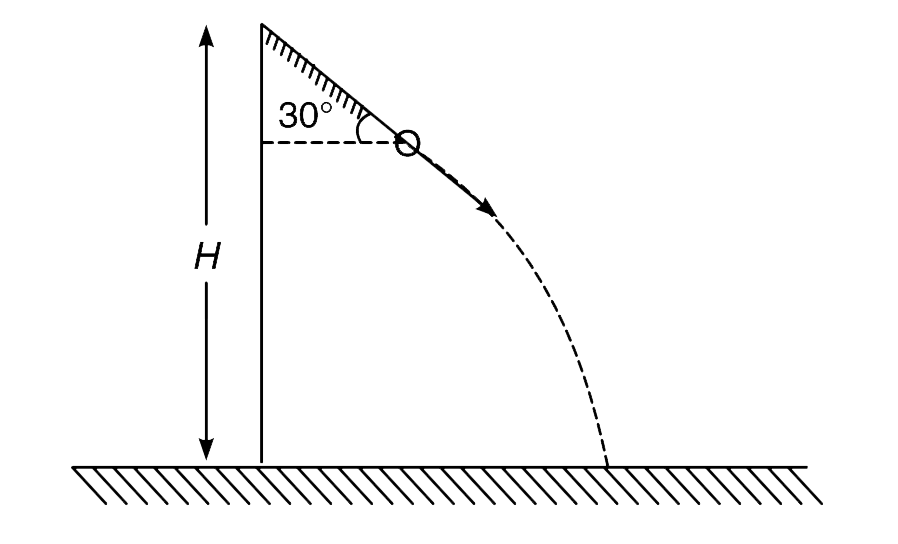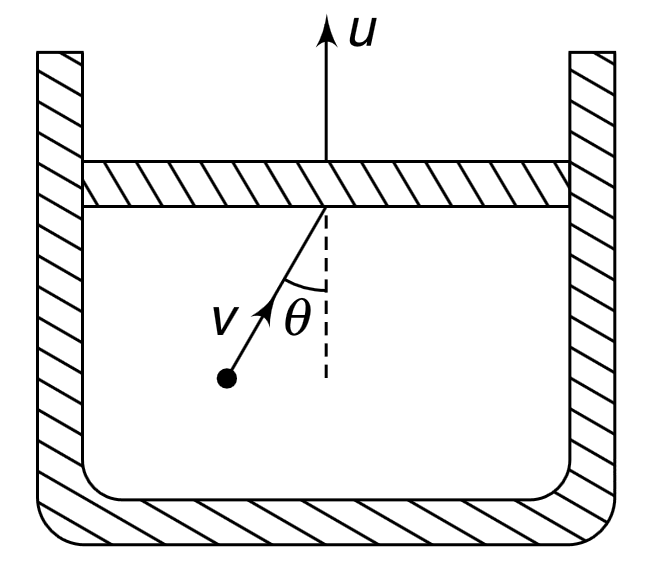Starting from a height H, a ball slips without friction, down a plane inclined at an angle of 30∘ to the horizontal (fig.). After leaving the inclined plane it fall under gravity on a parabolic path and hits the horizontal ground surface. The impact is perfectly elastic (It means that there is no change in horizontal component of ball’s velocity and its vertical velocity component gets inverted. There is no change in speed due to collision). Will the ball rise to a height equal to H or less than H after the impact ?

The correct Answer is:less than H
Step by step video, text & image solution for Starting from a height H, a ball slips without friction, down a plane inclined at an angle of 30^(@) to the horizontal (fig.). After leaving the inclined plane it fall under gravity on a parabolic path and hits the horizontal ground surface. The impact is perfectly elastic (It means that there is no change in horizontal component of ball’s velocity and its vertical velocity component gets inverted. There is no change in speed due to collision). Will the ball rise to a height equal to H or less than H after the impact ? by Physics experts to help you in doubts & scoring excellent marks in Class 11 exams.
Topper's Solved these Questions
Similar Questions
An ideal gas is inside a cylinder with a piston that can move freely. The walls of the cylinder and piston are non- conducting. The piston is being moved out of the cyl- inder at a constant speed u.
(a) Consider a gas molecule of mass m moving with speed v(>>u). It hits the piston elastically at an angle of incidence q. Calculate the loss in kinetic energy of the molecule.
(b) If the area of piston is A and pressure of the gas is P, calculate the rate of decreases of molecular kinetic energy of the gas sample.
(c) Ifu>> molecular velocities, at what rate will the gas lose its molecular kinetic energy
 View Solution
View SolutionLet →u be the initial velocity of a particle and →F be the resultant force acting on it . Describe the path that the particle can take if
(a) →u×→F=0and→F=constant
(b) →u.→F=0and→F=constant
In which case can the particle retrace its path .01:42View SolutionA ball falls on an inclined plane of inclinatioin θ from a height h above the pontof impact and makes a perfectly elastic collision. Where will it hit the plane again?
05:48View SolutionA ball falls vertically on an inclined plane of inclination alpha with speed v_0 and makes a perfectly elastic collision. What is angle of velocity vector with horizontal after collision.
04:11View SolutionIn figure, the angle of inclination of the inclined plane is 30^@ . Find the horizontal velocity V_0 so that the particle hits the inclined plane perpendicularly. .
04:21View SolutionThe least coefficient of friction for an inclined plane inclined at an angle alpha with horizontal, in order that a solid cylinder will roll down it without slipping ?
02:28View Solutionएक वायुयान क्षैतिज से 30∘ के कोण पर उड़ रहा है | यदि उसके वेग का ऊर्ध्वाधर घटक 100 मीटर/सेकंड हो तो उसका वास्तविक वेग तथा क्षैतिज घटक ज्ञात कीजिए |
09:45View SolutionA ring starts to roll down the inclined plane of height h without slipping . The velocity when it reaches the ground is
02:05View SolutionA ball starts falling freely from a height h from a point on the inclined plane forming an angle alpha with the horizontal as shown. After collision with the incline it rebounds elastically off the plane. Then it again strikes the incline at
04:15View SolutionA velocity is inclined at 30^(@) to the horizontal . If its rectangular component in horizontal direction is 40 km//hr , find the magnitude of velocity and its vertical component.
10:09View SolutionThe least coefficient of friction for an inclined plane inclined at angle alpha with horizontal in order that a solid cylinder will roll down without slipping is
04:29View SolutionA ball falls vertically on an inclined plane of inclination α with speed v0 and makes a perfectly elastic collision. What is angle of velocity vector with horizontal after collision.
10:09View SolutionA ball falls from height h over an inclined plane of inclination 30^@ as shown. After the collision, the ball moves horizontally, the coefficient of restitution is
03:57View SolutionA ball falls vertically on an inclined plane of inclination alpha with speed v_0 and makes a perfectly elastic collision. What is angle of velocity vector with horizontal after collision.
07:31View SolutionIn figure, the angle of inclination of the inclined plane is 30∘. Find the horizontal velocity V0 so that the particle hits the inclined plane perpendicularly.
 . 04:21View Solution
. 04:21View Solution

